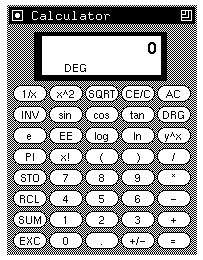

Calculator Key Usage: The numbered keys, the +/- key, and the +, -, *, /, and = keys all do exactly what you would expect them to. It should be noted that the operators obey the standard rules of precedence. Thus, entering "3+4*5=" results in "23", not "35". The parentheses can be used to override this. For example, "(1+2+3)*(4+5+6)=" results in "6*15=90".
The action procedures associated with each function are given below:
1/x Replaces the number in the display with its reciprocal.
x^2 Squares the number in the display.
SQRT Takes the square root of the number in the display.
CE/C When pressed once, clears the number in the display
without clearing the state of the machine. Allows
you to re-enter a number if you make a mistake.
Pressing it twice clears the state, also.
AC Clears the display, the state, and the memory.
Pressing it with the third pointer button turns off
the calculator, in that it exits the program.
INV Invert function. See the individual function keys for
details.
sin Computes the sine of the number in the display, as
interpreted by the current DRG mode (see DRG, below).
If inverted, it computes the arcsine.
cos Computes the cosine, or arccosine when inverted.
tan Computes the tangent, or arctangent when inverted.
DRG Changes the DRG mode, as indicated by 'DEG', 'RAD',
or 'GRAD' at the bottom of the calculator ``liquid
crystal'' display. When in 'DEG' mode, numbers in
the display are taken as being degrees. In 'RAD'
mode, numbers are in radians, and in 'GRAD' mode,
numbers are in grads. When inverted, the DRG key
has a feature of converting degrees to radians to
grads and vice- versa. Example: put the calculator
into 'DEG' mode, and enter "45 INV DRG". The
display should now show something along the lines
of ".785398", which is 45 degrees converted to
radians.
e The constant 'e'. (2.7182818...).
EE Used for entering exponential numbers. For example, to
get "-2.3E-4" you'd enter "2 . 3 +/- EE 4 +/-".
log Calculates the log (base 10) of the number in the
display. When inverted, it raises "10.0" to the
number in the display. For example, entering "3
INV log" should result in "1000".
ln Calculates the log (base e) of the number in the
display. For example, entering "e ln" should
result in "1".
y^x Raises the number on the left to the power of the
number on the right. For example "2 y^x 3 ="
results in "8", which is 2^3. For a further
example, "(1+2+3) y^x (1+2) =" equals "6 y^x 3"
which equals "216".
PI The constant 'pi'. (3.1415927....)
x! Computes the factorial of the number in the
display. The number in the display must be an
integer in the range 0-500, though, depending on
your math library, it might overflow long before
that.
( Left parenthesis.
) Right parenthesis.
/ Division.
* Multiplication.
- Subtraction.
+ Addition.
= Perform calculation.
STO Copies the number in the display to the memory location.
RCL Copies the number from the memory location to the display.
SUM Adds the number in the display to the number in the memory
location.
EXC Swaps the number in the display with the number in the
memory location.
+/- Negate; change sign.
. Decimal point.
accelerators
Accelerators are shortcuts for entering commands. xcalc
provides some sample keyboard accelerators; also users can
customize accelerators. The numeric keypad accelerators
provided by xcalc should be intuitively correct (i.e.,
pressing "1" on the keyboard is like clicking the "1" button
on the calculator).
Following Section 19.4.4, one can track the progress of an Object-Oriented Project by a set of technical milestones. Each of these phases will result in a document to turn in.